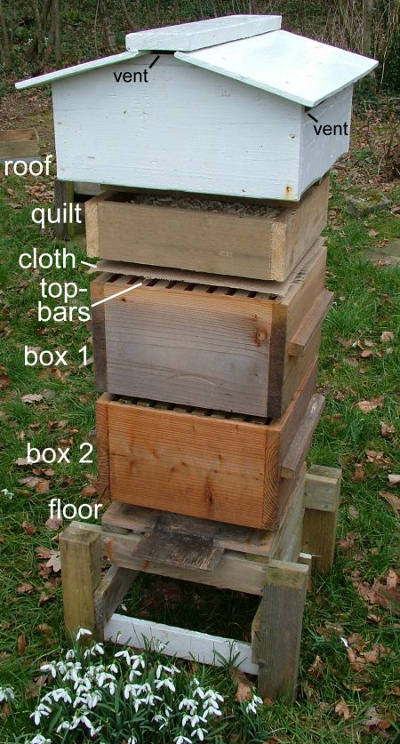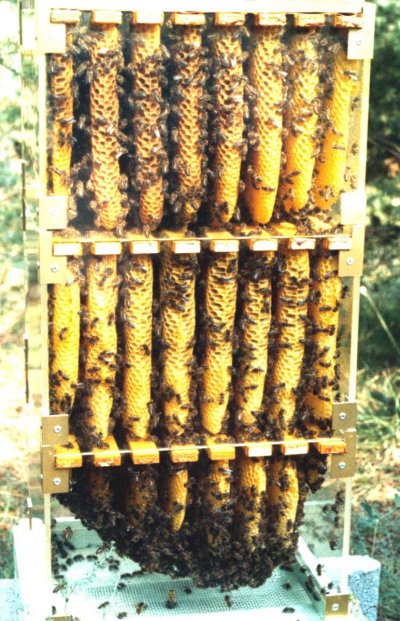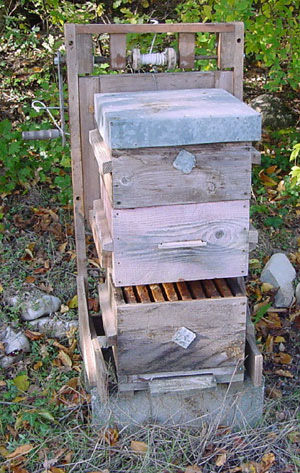
Warre hive
 The Warre hive (sometimes
called the "vertical top bar hive") is named after a French abbot who
developed a simple hive that could easily be constructed by the common
Joe. On the surface, the hive looks a lot like the Langstroth
hives that are so common in the U.S., but the boxes are smaller, the
wood is thicker, and there's an insulated "quilt' and roof area.
In addition, beekeepers usually use top bars instead of framed
foundation.
The Warre hive (sometimes
called the "vertical top bar hive") is named after a French abbot who
developed a simple hive that could easily be constructed by the common
Joe. On the surface, the hive looks a lot like the Langstroth
hives that are so common in the U.S., but the boxes are smaller, the
wood is thicker, and there's an insulated "quilt' and roof area.
In addition, beekeepers usually use top bars instead of framed
foundation.
Even though the Warre
hive resembles the Langstroth hive, it is managed in a completely
different manner. Warre beekeepers believe that protection of the
natural heat and scent within the hive is of utmost importance, and
that every type of manipulation by the beekeeper requires the bees to
work harder to maintain the Nestduftwarmebindung. So beekeepers
refrain from rearranging combs (for example, to open
up the brood box)
since that moves scents around, and they strive not to take the top off
the hive more than once a year.
Despite what that last
sentence sounds like, Warre beekeepers don't ignore their bees all year
and then expect to harvest lots of honey. They understand that
the larger a hive is, the harder the bees have to work to keep out wax
moths and diseases, so they add extra boxes at intervals throughout the
spring and summer just like a Langstroth beekeeper would. The
difference is that they put the boxes on the bottom --- nadiring ---
which is achieved by hefting the whole hive upward using a pulley-based
hive lift. The bees barely notice the intrusion, and the
Nestduftwarmebindung stays in place within the hive.
 Throughout the year, Warre
beekeepers also spend a lot of time observing the hive to ensure that
all's well within. They listen to the hive, watch and smell at
the entrance, and even put their hand on the quilt that covers the top
box to estimate its warmth. Many beekeepers weigh their hives to
check on honey stores, and some Warre boxes have observation windows
(fitted within insulated shutters when not in use) to allow
non-intrusive viewing.
Throughout the year, Warre
beekeepers also spend a lot of time observing the hive to ensure that
all's well within. They listen to the hive, watch and smell at
the entrance, and even put their hand on the quilt that covers the top
box to estimate its warmth. Many beekeepers weigh their hives to
check on honey stores, and some Warre boxes have observation windows
(fitted within insulated shutters when not in use) to allow
non-intrusive viewing.
In the fall, the
beekeeper opens up the hive more fully for the first time. In the
past months, the bees have filled up box after box, naturally moving
their brood area into new boxes below and replacing brood above with
honey. The beekeeper is able to remove whole boxes of honey off
the top to crush
and strain, which is
the most intrusion the hive ever sees.
Here's the catch ---
Warre hives don't produce as much honey as Langstroth hives. In The
Bee-friendly Beekeeper,
David Heaf notes that you should expect only half as much honey from a
Warre hive as from a Langstroth hive, and Heaf insinuates that forcing
bees to make so much honey is one of the factors that leads to decline
of modern apiaries.
 On the other hand, Heaf also
argues that Warre hives don't need as much honey to get them through
the winter due to the better thermal performance of the hive. He
leaves only 26 pounds of honey for his hives in the UK and says that,
in general, Warre hives need about 67% as much honey to overwinter as
Dadant hives do. (Dadant hives are related to Langstroth hives,
but have fallen out of favor.)
On the other hand, Heaf also
argues that Warre hives don't need as much honey to get them through
the winter due to the better thermal performance of the hive. He
leaves only 26 pounds of honey for his hives in the UK and says that,
in general, Warre hives need about 67% as much honey to overwinter as
Dadant hives do. (Dadant hives are related to Langstroth hives,
but have fallen out of favor.)
I'm very torn about the
idea of adding a Warre hive to our homestead, but not because of the
lower honey yields. On the one hand, the Nestduftwarmebindung
principle makes intuitive sense to me, especially once I read that a
hive can sometimes take three days to regain its temperature after
being opened and that cool temperatures in the hive can encourage pests
and diseases. On the other hand, I'm a nervous nellie, and can't
quite imagine not going through the brood nest at intervals to make
sure everything's okay. I'm also envisioning setting up a hive
lift wrong and ending up with bees spilled all over the ground, and
losing lots of swarms to the world since you can't manage reproduction
very well in the Warre hive. (More on that in a later post.)
On the third hand, it's
new, different, and intriguing. How could I resist?
| This post is part of our Warre Hive lunchtime series.
Read all of the entries: |
Want more in-depth information? Browse through our books.
Or explore more posts by date or by subject.
About us: Anna Hess and Mark Hamilton spent over a decade living self-sufficiently in the mountains of Virginia before moving north to start over from scratch in the foothills of Ohio. They've experimented with permaculture, no-till gardening, trailersteading, home-based microbusinesses and much more, writing about their adventures in both blogs and books.
Want to be notified when new comments are posted on this page? Click on the RSS button after you add a comment to subscribe to the comment feed, or simply check the box beside "email replies to me" while writing your comment.

I had one hive I started 4 years ago, I lost it in its second winter. So, last year I bought 2 bee/queen packages of bees and set up 2 hives. Then a spring bear came along and destroyed them.
So this year I am setting up 2 hives with larger nukes that come with 5 frames that are fulle of larvea/honey and a queen. I am moving my hives down to a fenced in area.
I can not afford an electric fence so I will be hanging empty plastic milk cartens with and opening on the side and pine sol inside around the fence line.
I was told that bears noses are very sensative to oders and they do not hang around an area with strong chemical odors.
We will see how it goes. My bees come in April/May.
Mona --- I'm glad we don't have to deal with bears (so far)! I think Lucy keeps the perimeters smelly enough that wild animals (other than deer) steer clear.
I have read that some people deal with bears by hoisting hives up into trees! I think it might work best with top bar hives, and you have to be sure to get it level or they'll build comb crooked. An idea if you get desperate....